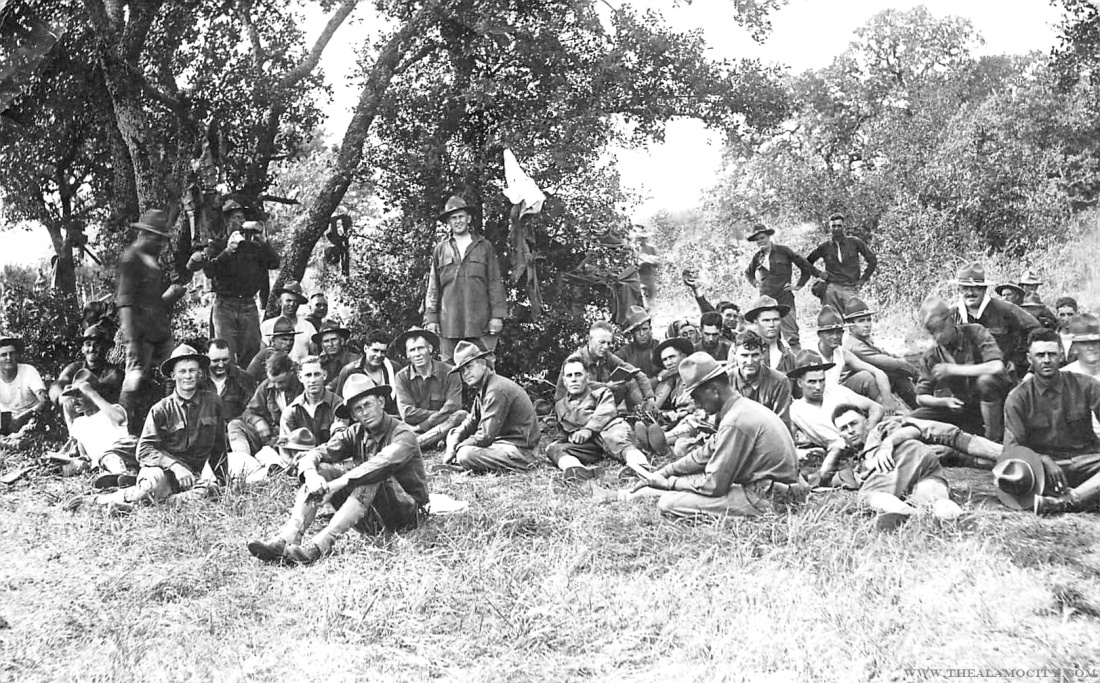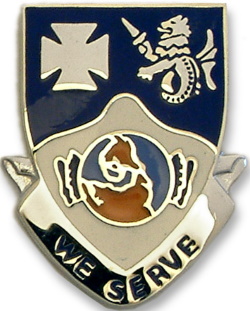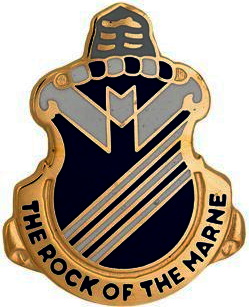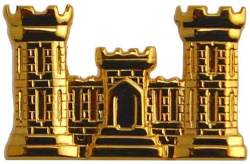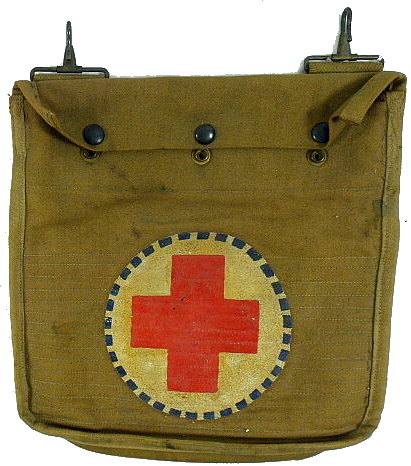Document Source: 1945 Brief History of the 2nd Infantry Division (Indian Head).
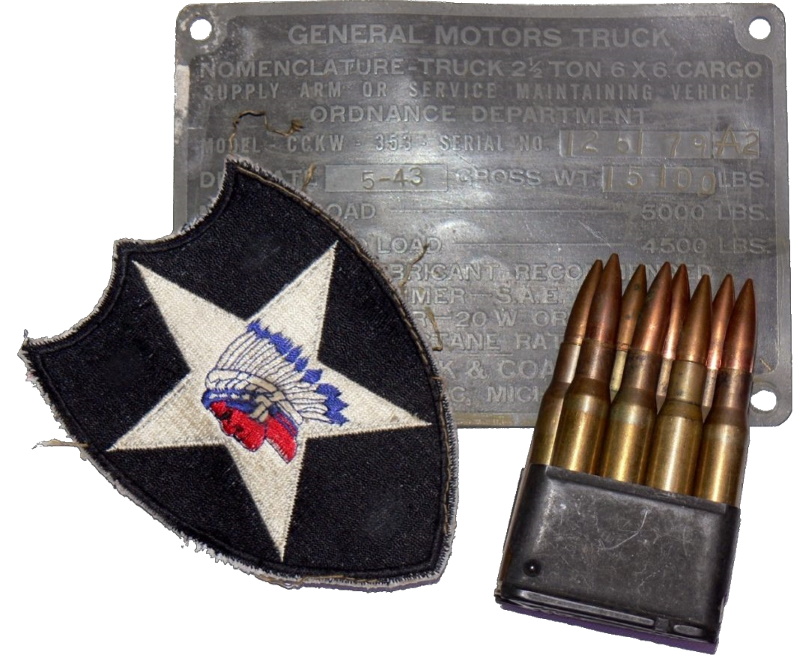 The members of the 2nd Infantry Division were the wearers of the famed Indian Head Patch in five different wars around the planet. This insignia had its origin during World War One as the identifying insignia on the vehicles of the Division Supply Trains. The Commanding Officer of the trains held a contest in March 1918, to select a distinctive identifying symbol for use upon the vehicles after he had seen the vehicles of adjacent French units decorated in this manner. Through his adjutant, he sent out a memorandum authorizing prizes for the best designs submitted, with the first prize of forty francs. The winning insignia, which obtained the final approval of Division Headquarters for use upon supply train vehicles in April 1918, was the striking red and blue Indian head, superimposed upon a white star. The head covered the re-entrant angles of the star and exposed only the points. Maj Gen Omar Bundy, the Division Commander, and his Chief of Staff, Col Preston Brown, later Maj Gen Preston Brown, were riding in a command car one day in April when Gen Bundy’s eye was caught by the insignia emblazoned on a truck.
The members of the 2nd Infantry Division were the wearers of the famed Indian Head Patch in five different wars around the planet. This insignia had its origin during World War One as the identifying insignia on the vehicles of the Division Supply Trains. The Commanding Officer of the trains held a contest in March 1918, to select a distinctive identifying symbol for use upon the vehicles after he had seen the vehicles of adjacent French units decorated in this manner. Through his adjutant, he sent out a memorandum authorizing prizes for the best designs submitted, with the first prize of forty francs. The winning insignia, which obtained the final approval of Division Headquarters for use upon supply train vehicles in April 1918, was the striking red and blue Indian head, superimposed upon a white star. The head covered the re-entrant angles of the star and exposed only the points. Maj Gen Omar Bundy, the Division Commander, and his Chief of Staff, Col Preston Brown, later Maj Gen Preston Brown, were riding in a command car one day in April when Gen Bundy’s eye was caught by the insignia emblazoned on a truck.
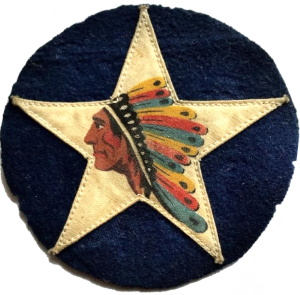 According to a letter from Maj Gen Brown written sometime later, Gen Bundy stopped the driver, asked the meaning of the device, and was told by the driver that it enabled him to find his vehicle in the dark. The letter does not bring out that the insignia had been authorized and was probably coming into use on all the vehicles of the trains but at that time and at any rate, the Gen and his Chief of Staff promptly sent their cars to the area to have the
According to a letter from Maj Gen Brown written sometime later, Gen Bundy stopped the driver, asked the meaning of the device, and was told by the driver that it enabled him to find his vehicle in the dark. The letter does not bring out that the insignia had been authorized and was probably coming into use on all the vehicles of the trains but at that time and at any rate, the Gen and his Chief of Staff promptly sent their cars to the area to have the 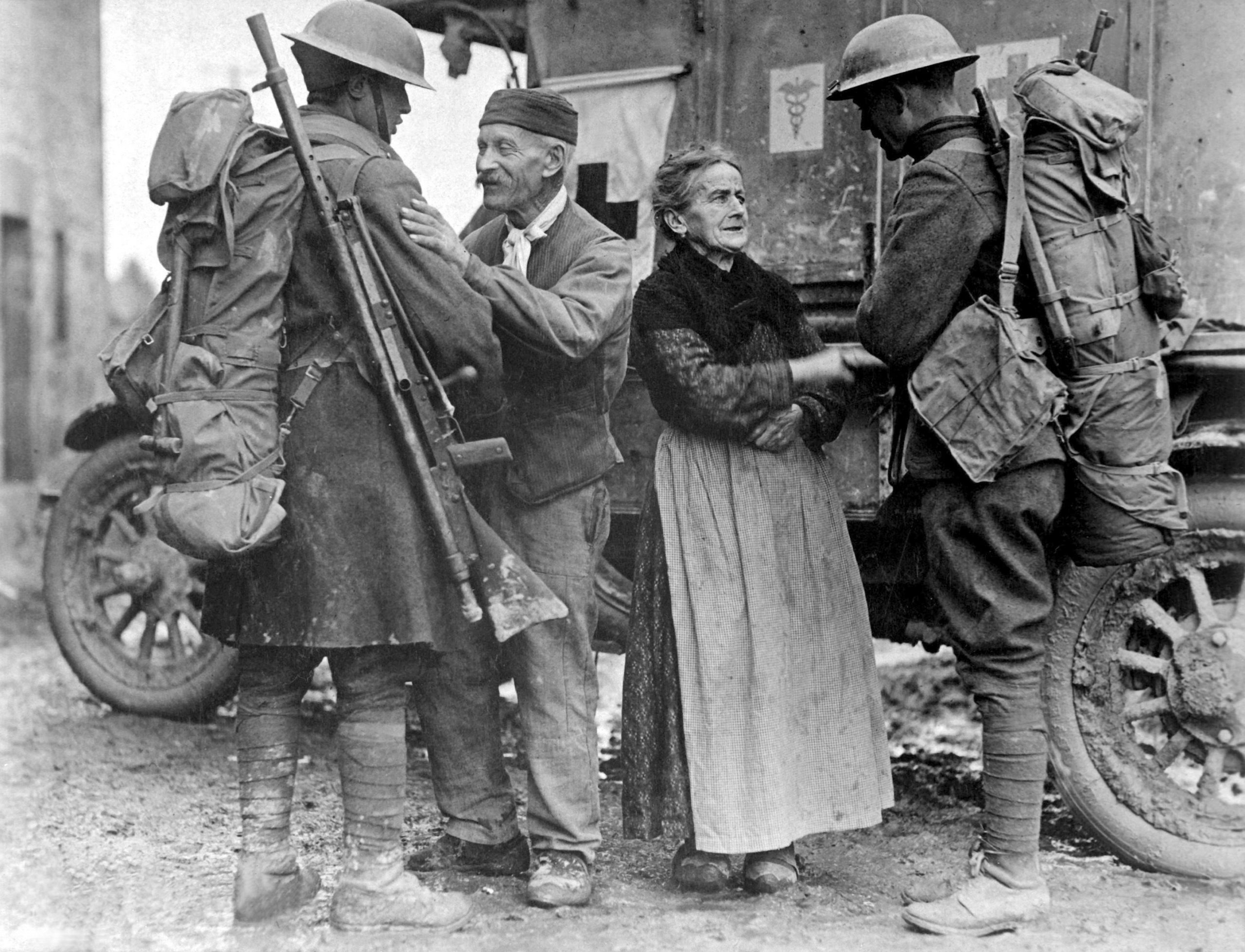 insignia painted upon them. In this manner, the Indian Head became associated with the 2nd Division as its identifying insignia sometime before it became the standard shoulder patch so proudly worn by men of the Division.
insignia painted upon them. In this manner, the Indian Head became associated with the 2nd Division as its identifying insignia sometime before it became the standard shoulder patch so proudly worn by men of the Division.
 In October 1918, the Commanding General of the American Expeditionary Force (CG-AEF), Gen John J. Pershing, requested units to furnish insignia for approval. Maj Gen John A. Lejeune, USMC, in reply to the request, submitted the red and blue Indian head upon a white star as the insignia of the 2nd Marine Division. The head was contained within the re-entrant angles of the star in this design, the whole contained within a circle three and one-half inches in diameter. As the Indian head in the representation was somewhat crudely constructed, it was designated that the Saint-Gaudens Indian, in use on the five-dollar gold piece, be substituted. On November 14, 1918, an order was published by Headquarters 2nd Division announcing that the insignia as described had been made official for the Division. The cloth background for the insignia was of varying shapes and colors, designating the major unit to which the individual wearer belonged and the subordinate unit. The background chosen for the Division’s Headquarters was the black shield.
In October 1918, the Commanding General of the American Expeditionary Force (CG-AEF), Gen John J. Pershing, requested units to furnish insignia for approval. Maj Gen John A. Lejeune, USMC, in reply to the request, submitted the red and blue Indian head upon a white star as the insignia of the 2nd Marine Division. The head was contained within the re-entrant angles of the star in this design, the whole contained within a circle three and one-half inches in diameter. As the Indian head in the representation was somewhat crudely constructed, it was designated that the Saint-Gaudens Indian, in use on the five-dollar gold piece, be substituted. On November 14, 1918, an order was published by Headquarters 2nd Division announcing that the insignia as described had been made official for the Division. The cloth background for the insignia was of varying shapes and colors, designating the major unit to which the individual wearer belonged and the subordinate unit. The background chosen for the Division’s Headquarters was the black shield.
 In April 1933, Maj Gen Preston Brown, taking command of the Division, abolished the differentiation of all the backgrounds in use and made the black shield official for all elements of the 2nd Division. With proud traditions and wearing the Fourragère of the Croix de Guerre won at Soissons and Mont Blanc during World War One, the 2nd Infantry Division entered the War in the European Theater of Operations (ETO) with the incomparable esprit which comes from a notable heritage. In the Normandy Peninsula, at the Siege of Brest, on the Siegfried Line, racing across Central Europe, and in the last days of the Wehrmacht’s disintegrating power in Czechoslovakia, the Division for the second time proved itself Second to None in upholding its country’s finest military traditions. Its operations and achievements reflect credit upon the army of which it was a part and upon the men who fought its battles through the campaigns of Normandy, Northern France, the Rhineland (Germany), the Ardennes, and Central Europe. The impressive array of battle honors and individual citations won can only indicate the untold acts of gallantry and great fighting spirit which marked eleven months of combat in German-held Europe.
In April 1933, Maj Gen Preston Brown, taking command of the Division, abolished the differentiation of all the backgrounds in use and made the black shield official for all elements of the 2nd Division. With proud traditions and wearing the Fourragère of the Croix de Guerre won at Soissons and Mont Blanc during World War One, the 2nd Infantry Division entered the War in the European Theater of Operations (ETO) with the incomparable esprit which comes from a notable heritage. In the Normandy Peninsula, at the Siege of Brest, on the Siegfried Line, racing across Central Europe, and in the last days of the Wehrmacht’s disintegrating power in Czechoslovakia, the Division for the second time proved itself Second to None in upholding its country’s finest military traditions. Its operations and achievements reflect credit upon the army of which it was a part and upon the men who fought its battles through the campaigns of Normandy, Northern France, the Rhineland (Germany), the Ardennes, and Central Europe. The impressive array of battle honors and individual citations won can only indicate the untold acts of gallantry and great fighting spirit which marked eleven months of combat in German-held Europe.
BACK TO WORLD WAR ONE
The 2nd Division completed its organization as a division on Nov 18, 1917, in France, under the command of Maj Gen Omar Bundy. Elements of the division had received training prior to overseas movement at Pine Camp, New York, and had joined in the spirited race to be the first American unit overseas. On arrival in France, the division was activated with the veteran 9th Regiment and the 23rd Regiment making up the 3rd Brigade; the 5th and the 6th Marine Regiments composing the 4th Brigade, and the 12th, 15th and 17th Field Artillery Regiments plus the 2nd Engineer Regiment and the 2nd Sanitary Train. Following a short tour of duty as occupational troops along the Rhine River after the first World War, the division returned to the USA in Aug 1919, and was stationed at Fort Sam Houston, Texas, and then at Camp Travis, Texas, where it remained in garrison for 23 years.
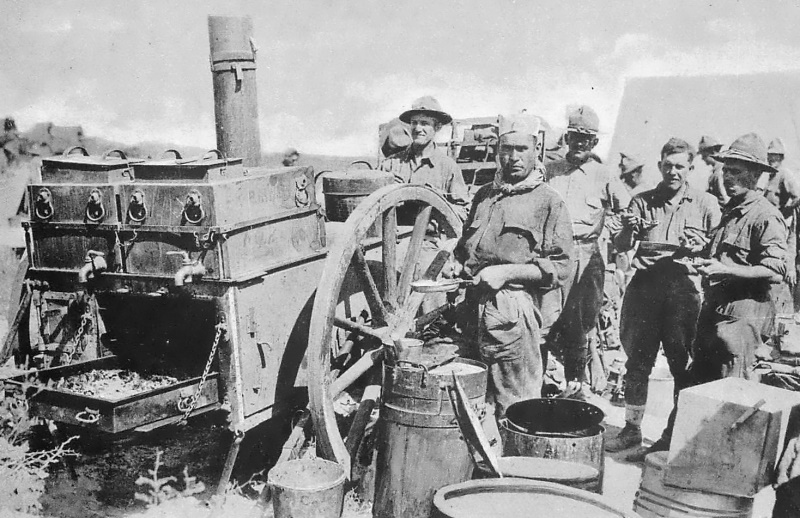 The 4th Marine Brigade, composed of the 5th Marine and 6th Marine Regiments, was inactivated and was subsequently replaced by the 4th Brigade, comprised of the 1st Regiment and the 20th Regiment, later dropped and stationed at what is now Fort Francis D. Warren, Wyoming. In Oct 1940, with the dropping of the 4th Brigade, the Division underwent a streamlining. It became the first triangular division, organized from the 9th and the 23rd Regiments with the 38th Regiment completing the triangle. At the same time, the 15-FAR was divided into three battalions, the 37th, the 38th, and the 15-FABs. The 12-FAR was reduced in size to become the 12-FAB, the fourth unit included in Division Artillery. The 2-ER became the 2-ECB, and the 2-MDR, which had been formed in 1921 from the old 2nd Sanitary Train, became the 2-MB (Medic). The integral parts now comprising the reorganized 2-ID were the 9-IR, the 23-IR, and the 38-IR; the 12-FAB, 15-FAB, 37-FAB, and the 38-FAB, and Hq Battery Division Artillery. The 2-MB (Medic); the 2-ECB; and special troops including Hq Co, the 2nd Signal Co, the 2nd QM Co, the 702nd Light Ordnance and Maintenance Co, the 2nd Recon Troop Mez, and the Military Police Platoon. Some of these component parts of the Division have separate and distinct histories as military organizations. Some have records of military service extending far into the roots of this nation’s past and forming an integral part of American history. Others are products of the modernization of the nation’s armed forces in recent times.
The 4th Marine Brigade, composed of the 5th Marine and 6th Marine Regiments, was inactivated and was subsequently replaced by the 4th Brigade, comprised of the 1st Regiment and the 20th Regiment, later dropped and stationed at what is now Fort Francis D. Warren, Wyoming. In Oct 1940, with the dropping of the 4th Brigade, the Division underwent a streamlining. It became the first triangular division, organized from the 9th and the 23rd Regiments with the 38th Regiment completing the triangle. At the same time, the 15-FAR was divided into three battalions, the 37th, the 38th, and the 15-FABs. The 12-FAR was reduced in size to become the 12-FAB, the fourth unit included in Division Artillery. The 2-ER became the 2-ECB, and the 2-MDR, which had been formed in 1921 from the old 2nd Sanitary Train, became the 2-MB (Medic). The integral parts now comprising the reorganized 2-ID were the 9-IR, the 23-IR, and the 38-IR; the 12-FAB, 15-FAB, 37-FAB, and the 38-FAB, and Hq Battery Division Artillery. The 2-MB (Medic); the 2-ECB; and special troops including Hq Co, the 2nd Signal Co, the 2nd QM Co, the 702nd Light Ordnance and Maintenance Co, the 2nd Recon Troop Mez, and the Military Police Platoon. Some of these component parts of the Division have separate and distinct histories as military organizations. Some have records of military service extending far into the roots of this nation’s past and forming an integral part of American history. Others are products of the modernization of the nation’s armed forces in recent times.
The oldest unit of the Division is the venerable 9-IR, rich in military lore and tradition. Activated in 1798, it was demobilized shortly thereafter and reactivated in 1812, participating in five major engagements of the War with England, the Capture of York, Fort George, Sackett’s Harbor, Fort Erie, and the Chippewa River Battle. Disbanded in 1814, it was reorganized in 1847 for the War with Mexico, in which it fought at Cerro Gordo, the Invasion of the Valley of Mexico, Contreras, Churubusco, and Chapultepec. In 1848, after two wars in which it fought under that impressive battle-figure Gen Winneld Scott, it was disbanded for the third time. Banded together for the fourth time in 1855, the regiment has remained in active service ever since. Between 1855 and 1892 it was credited with no less than 400 battles and skirmishes along the American Frontier. It participated in the Civil War, the Spanish-American War of 1898, the Philippine Insurrection of 1899, and the Boxer Rebellion in China in 1900-1901. During the war in China at the Battle of Tientsin, the regiment won its most prized trophy.
A detachment saved a Chinese mint from being looted and was presented two ingots of silver by the grateful government. A twenty-gallon punch bowl and 50 silver cups, ornate with the five-clawed Manchu dragon, were made from the ingots. This trophy is called the Liscum Bowl in memory of a gallant regimental commander who seized the colors from a fallen color guard and held them high until he himself fell mortally wounded. It was in China, too, that the 9th Infantry won its sobriquet, the Manchu Regiment, and added the dragon to its regimental coat of arms.
Ordered overseas in 1917 for duty with the American Expeditionary Force (AEF), the 9th Infantry was assigned to duty with the 2nd Division, of which it has been an integral part ever since. It participated in the campaigns of the Aisne, Aisne & Marne, Saint-Mihiel, and the Meuse Argonne. For its combat performance, it wears the Fourragère in the colors of the Croix de Guerre, for having been cited twice in Orders of the French Army. Later, as part of the Army of Occupation in the Rhineland (Germany), it was stationed at Bendorf, until it was transferred in Aug 1919 to Fort Sam Houston, Texas.
Battle streamers awarded to the 9th Infantry include: Washington (1856-1857); Wyoming (1866-1867); Little Big Horn, Mississippi (1862); Kentucky (1864); Murfrees Boro, Tennessee (1863); Chickamauga, Chattanooga, Georgia & Atlanta (1864); Santiago, San Isidore Luzon (1899- 1900); Zapote River-Malolos, Tarlac-Samar (1901); Tientsin, Yang-Tsun Peking, China; Lorraine; Aisne; Ile de France; Aisne & Marne; Saint-Mihiel; Meuse & Argonne and the Streamer of the Croix de Guerre.
The next oldest unit of the division is the 23rd Infantry. It was organized in June 1812 and participated in thirteen battles and skirmishes of that war including Sackett’s Harbor, Lundy’s Lane, and the Capture of Fort Erie. In May 1815, elements of the regiment helped form the 2nd Infantry of that time, and the 23rd Infantry ceased to exist under that name until after the Civil War when the 2nd Battalion of the 14th Infantry was designated by that name. This Battalion, organized in 1862, served through the Civil War amassing battle honors which the 23rd Infantry assumed on its activation in 1866. One company of the Regiment served as garrison at Sitka, Alaska, from April 1869 to June 1870, adding the Russian Bear and the totem pole to its regimental coat of arms. Between the Civil War and the Spanish-American War, the Regiment participated in numerous Indian Wars. After the Spanish-American War, in which the Regiment participated in the Capture of Manila, it took part in the quelling of the Philippine Insurrection and returned to the States in 1901. The Regiment saw two other periods of duty in the Philippine Islands, in 1903-1905 and in 1908-1910 then the time from 1913 to 1917 was spent on guard duty on the Mexican Border.
Sent to France as part of the 2nd Division in Sept 1917, the 23rd Infantry participated in six major engagements of that war and was twice cited in the Orders of the French Army. For this honor, the members now wear the Fourragère in colors of the Croix de Guerre. Following its term of service with the Army of Occupation in the Rhineland (Germany), after World War One, the Regiment returned to the United States on Aug 4, 1919.
Battle streamers awarded the 23rd Regiment include the: Peninsular Campaign; Manassas; Fredericksburg; Antietam; Chancellorsville, Gettysburg, Virginia (1863); Wilderness; Spotsylvania; Cold Harbor, Petersburg, Arizona (1866); Idaho (1868); Little Big Horn (1862); Manila, Manila-Malolos; Lorraine; Aisne; Ile de France; Marne; Saint-Mihiel; Meuse & Argonne and the Streamer of the Croix de Guerre.
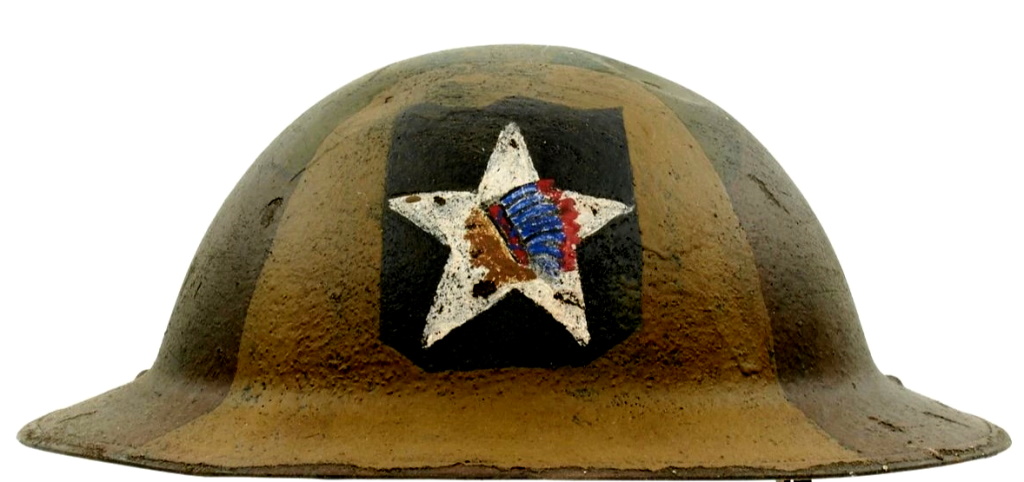 The 38th Infantry, a unit of the 3rd Division in WW-1, became a part of the 2nd Division in 1940 when the change was made from a square division to a triangular division. This regiment was activated on Jun 1, 1917, at Syracuse, New York, and earned its sobriquet ‘Rock of the Marne’, on Jul 15, 1918, when in the pre-dawn darkness eight miles east of Chateau Thierry it stopped a desperate head-on thrust of the German 10th and 36th Divisions, halting a concentrated attack. Gen John J. Pershing, CG AEF, in his report to the Secretary of War of the United States, nine days after the signing of the Armistice, said in his one mention of an individual regiment:
The 38th Infantry, a unit of the 3rd Division in WW-1, became a part of the 2nd Division in 1940 when the change was made from a square division to a triangular division. This regiment was activated on Jun 1, 1917, at Syracuse, New York, and earned its sobriquet ‘Rock of the Marne’, on Jul 15, 1918, when in the pre-dawn darkness eight miles east of Chateau Thierry it stopped a desperate head-on thrust of the German 10th and 36th Divisions, halting a concentrated attack. Gen John J. Pershing, CG AEF, in his report to the Secretary of War of the United States, nine days after the signing of the Armistice, said in his one mention of an individual regiment:
A single regiment of the 3rd Division wrote one of the most brilliant pages in our military annals on this occasion. It prevented the crossing at certain points on its wide front while on either flank  the Germans who had gained a foothold pressed forward. The men of this one regiment, firing in three directions, met German attacks with counterattacks at critical points and succeeded in throwing two German elite divisions into complete confusion, capturing more than 600 soldiers.
the Germans who had gained a foothold pressed forward. The men of this one regiment, firing in three directions, met German attacks with counterattacks at critical points and succeeded in throwing two German elite divisions into complete confusion, capturing more than 600 soldiers.
For outstanding performance of duty in France and for unshakable tenacity the Regiment was cited – an elite regiment – by Gen Philippe Petain and was awarded the Croix de Guerre with Palm. As Rhineland occupation troops, the 38th Infantry was billeted in Niedermendig, Obermendig, Ettinger, and St Johann, in Germany. It embarked for the US eight months later at Brest, France. The 38th Infantry carries battle streamers on its colors for the campaigns of Aisne; Champagne; Champagne & Marne; Saint-Mihiel; Meuse & Argonne.
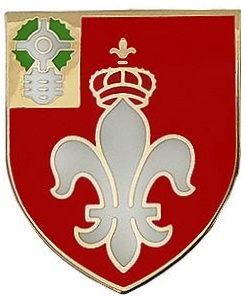 12th Field Artillery Battalion
12th Field Artillery Battalion
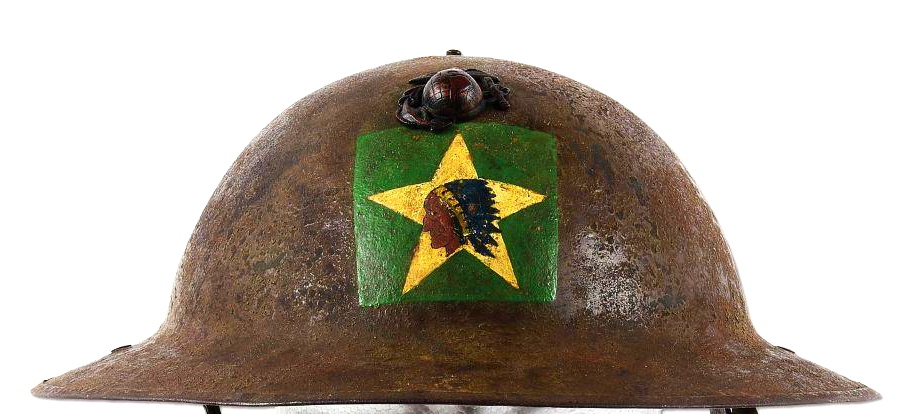 The 12th Field Artillery Battalion also saw action in the last war. It was organized in June 1917, from a cadre of the 3rd Field Artillery Battalion. The single Fleur de Lys in its coat of arms comes from the city of Soissons where it won the Croix de Guerre with Palm of the French Government. The golden crown on the Fleur de Lys comes from Verdun where the unit received its baptism of fire. The green Aztec war bonnet is derived from its parent organization, the 3rd Field Artillery, which saw service in Mexico. The 12th FAB wears the Fourragère in colors of the Croix de Guerre and the streamers of that French decoration. It served in the Army of Occupation in the Rhineland for eight months and was then sent back to Fort Sam Houston, Texas. There, in 1940, it was reduced to battalion strength and reorganized as a medium field artillery battalion with the 2nd Division.
The 12th Field Artillery Battalion also saw action in the last war. It was organized in June 1917, from a cadre of the 3rd Field Artillery Battalion. The single Fleur de Lys in its coat of arms comes from the city of Soissons where it won the Croix de Guerre with Palm of the French Government. The golden crown on the Fleur de Lys comes from Verdun where the unit received its baptism of fire. The green Aztec war bonnet is derived from its parent organization, the 3rd Field Artillery, which saw service in Mexico. The 12th FAB wears the Fourragère in colors of the Croix de Guerre and the streamers of that French decoration. It served in the Army of Occupation in the Rhineland for eight months and was then sent back to Fort Sam Houston, Texas. There, in 1940, it was reduced to battalion strength and reorganized as a medium field artillery battalion with the 2nd Division.
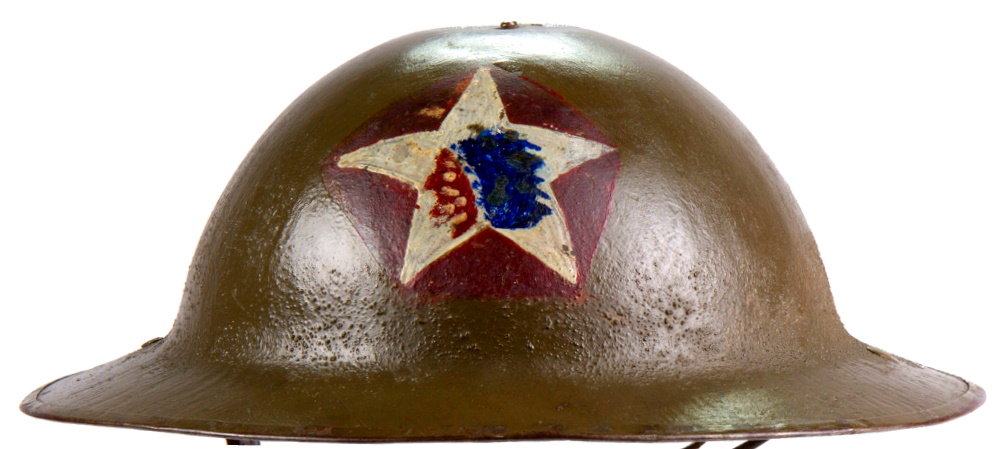 As a regiment the organization engaged in the Aisne; Chateau-Thierry; Aisne & Marne; Saint-Mihiel; Champagne and Meuse & Argonne.
As a regiment the organization engaged in the Aisne; Chateau-Thierry; Aisne & Marne; Saint-Mihiel; Champagne and Meuse & Argonne.
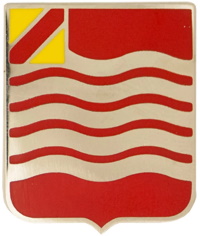 15th Field Artillery Battalion
15th Field Artillery Battalion
The 15-FAB, parent organization of three of the Division’s four artillery units, was organized at Camp Pine, New York, on the eve of departure for overseas in August 1917. It was formed with a cadre from the 4th Field Artillery Regiment. Upon arrival in France in February 1918, it was assigned to duty with the 2nd Division. The 15-FAB was in continuous action from July 1918 to November 1918 and the signing of the Armistice. Decorated with the ribbons of the  Croix de Guerre for two citations by the French Ministry of War, the Meuse Argonne and the Aisne Marne campaigns, this organization served in the Army of Occupation until mid-summer of 1919 and then moved to Fort Sam Houston, Texas. On October 10, 1940, the regiment officially became three battalions, the 15-FAB, 37-FAB, and the 38-FAB. In this reorganization process, the 15-FAB retained the records, standards, and honors of the old regiment.
Croix de Guerre for two citations by the French Ministry of War, the Meuse Argonne and the Aisne Marne campaigns, this organization served in the Army of Occupation until mid-summer of 1919 and then moved to Fort Sam Houston, Texas. On October 10, 1940, the regiment officially became three battalions, the 15-FAB, 37-FAB, and the 38-FAB. In this reorganization process, the 15-FAB retained the records, standards, and honors of the old regiment.
The 15th Artillery Battalion saw action with that organization in Lorraine; Aisne; Ile de France; Aisne & Marne; Saint-Mihiel and Meuse & Argonne.
 HQ Battery, 2nd Division Artillery, was organized on Oct 1 1940, at Fort Sam Houston, Texas, its personnel being obtained by transfer from HQ Battery and 1/12th Field Artillery Regiment and HQ Battery of the 15th Field Artillery Regiment.
HQ Battery, 2nd Division Artillery, was organized on Oct 1 1940, at Fort Sam Houston, Texas, its personnel being obtained by transfer from HQ Battery and 1/12th Field Artillery Regiment and HQ Battery of the 15th Field Artillery Regiment.
The 2nd Engineer Combat Battalion is one of the few American units organized on foreign soil, having been created on July 1, 1916, at Colonia Dublan, Mexico, as a result of the expansion of the old 2nd Battalion of Engineers. Its history traces back to Charlie and Dog Companies of the Corps of Engineers, organized in 1861. Through these older organizations, the present Battalion has on its colors battle streamers of the Civil War, the Spanish American War, and the Philippine Insurrection. After participating in the Mexican punitive expedition in 1916 the battalion moved to France in Sept 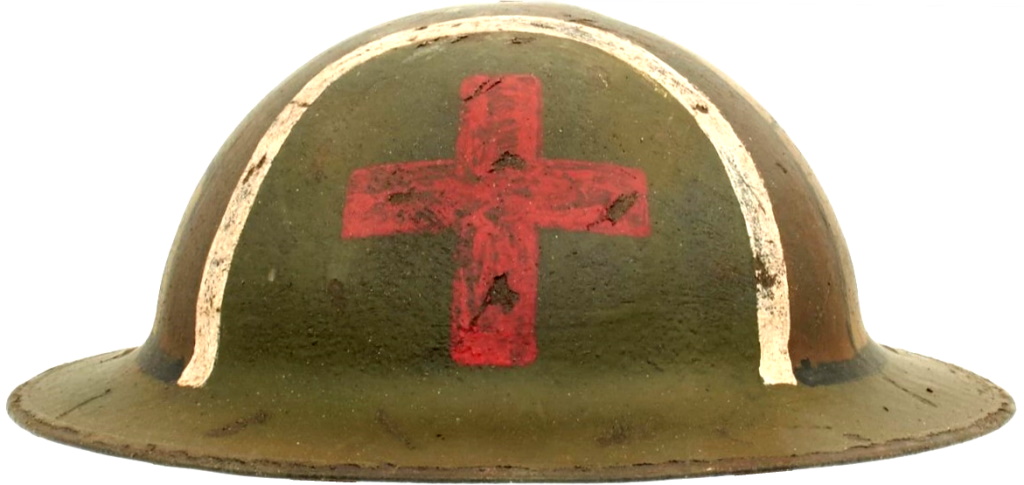 1917, as part of the 2nd Division when it was organized. Attached to the 36th Division, it fought through a short campaign with that organization. For outstanding exploits, it wears the French Fourragère, and served as part of the Army of Occupation at Enger am Rhine until Jul 1919 when it returned to Fort Sam Houston, Texas.
1917, as part of the 2nd Division when it was organized. Attached to the 36th Division, it fought through a short campaign with that organization. For outstanding exploits, it wears the French Fourragère, and served as part of the Army of Occupation at Enger am Rhine until Jul 1919 when it returned to Fort Sam Houston, Texas.
The 2nd Engineers participated in the campaigns at Chateau Thierry; Soissons; Saint-Mihiel; Mont Blanc; Attigny and Argonne.
The 2nd Medical Battalion is one of the oldest medical units in the entire army of the United States, dating back to 1894 and the so-called School of  Instructions, Hospital Corps, Washington Barracks. It was part of the Cuban Expeditionary Force from Oct 1906 to Nov 1908 and in Mar 1911, was reorganized as Field Hospital and Ambulance Company #1, Hospital Corps. The Battalion went overseas as part of the 2nd Sanitary Train of the 2nd Division in Aug 1918. Headquarters of the Sanitary Train was organized in France, and it assumed the history of Field Hospital and Ambulance Company #1. It was twice cited in French Orders of the Army and thus wears the Fourragère and streamers in the colors of the Croix de Guerre. After serving with the Army of Occupation while stationed at Sayn, Germany, until July 1919, the Train returned to Fort Sam Houston, Texas where it was reorganized as the 2nd Medical Regiment on Feb 17, 1921. It became the 2nd Medical Battalion on Oct 7, 1940.
Instructions, Hospital Corps, Washington Barracks. It was part of the Cuban Expeditionary Force from Oct 1906 to Nov 1908 and in Mar 1911, was reorganized as Field Hospital and Ambulance Company #1, Hospital Corps. The Battalion went overseas as part of the 2nd Sanitary Train of the 2nd Division in Aug 1918. Headquarters of the Sanitary Train was organized in France, and it assumed the history of Field Hospital and Ambulance Company #1. It was twice cited in French Orders of the Army and thus wears the Fourragère and streamers in the colors of the Croix de Guerre. After serving with the Army of Occupation while stationed at Sayn, Germany, until July 1919, the Train returned to Fort Sam Houston, Texas where it was reorganized as the 2nd Medical Regiment on Feb 17, 1921. It became the 2nd Medical Battalion on Oct 7, 1940.
The Train was awarded battle honors for Lorraine; Aisne Defensive; Ile de France; Aisne & Marne; Meuse & Argonne and Saint-Mihiel.
 The 2nd Infantry Division Headquarters Company, the 2nd Signal Company, the 2nd Quartermaster Company, the 702nd Ordnance Company, the 2nd Reconnaissance Troop (Mez), and the 2nd Division Military Police Platoon began serving as units of the 2nd Infantry Division when it was triangulated. These complete the organization of the Division whose units fought together over some 1665 miles of enemy-held territory in eleven months of almost continual combat in World War II.
The 2nd Infantry Division Headquarters Company, the 2nd Signal Company, the 2nd Quartermaster Company, the 702nd Ordnance Company, the 2nd Reconnaissance Troop (Mez), and the 2nd Division Military Police Platoon began serving as units of the 2nd Infantry Division when it was triangulated. These complete the organization of the Division whose units fought together over some 1665 miles of enemy-held territory in eleven months of almost continual combat in World War II.
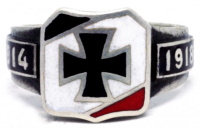 1914-1918
1914-1918
One German Soldier Wrote
The next morning, we left Sugny and an hour later we crossed the French – Belgian border. Here, too, we had to give three cheers. The borderline there runs through a wood, and on the other side of the wood, we placed the 21-CM (210-MM) mortars in position. Our troops were engaged with the rear guard of the enemy near the village of Vivier au Court in France and we were brought in to reinforce them.
 After a five hours’ fight, the last opponents had retired as far as the Meuse River. Vivier au Court had hardly suffered at all when we occupied it towards noon and our company halted again here to wait for the mortar battery. Meanwhile, we walked through the village to find some eatables. After visiting several houses we came upon the family of a teacher.
After a five hours’ fight, the last opponents had retired as far as the Meuse River. Vivier au Court had hardly suffered at all when we occupied it towards noon and our company halted again here to wait for the mortar battery. Meanwhile, we walked through the village to find some eatables. After visiting several houses we came upon the family of a teacher.
Father and son were both soldiers; two daughters of about twenty and twenty-two were alone with their mother. The mother was extremely shy, and all three women were crying when we entered the home.
The eldest daughter received us with great friendliness and, to our surprise, in faultless German. We endeavored to pacify the women, begging them not to cry; we assured them again and again that we would not harm them, and told them all kinds of merry stories to turn their thoughts to other things. One of my mates related that in a fight in the morning, we had lost seven men and that several on our side had been wounded. That only increased the women’s excitement, a thing we really could not understand.
 At last one of the girls, who had been the first one to compose herself, explained to us why
At last one of the girls, who had been the first one to compose herself, explained to us why  they were so much excited. The girl had been at a boarding school at Charlottenburg (Germany) for more than two years, and her brother, who worked in Berlin as a civil engineer, had taken a holiday for three months after her graduation in order to accompany his sister home.
they were so much excited. The girl had been at a boarding school at Charlottenburg (Germany) for more than two years, and her brother, who worked in Berlin as a civil engineer, had taken a holiday for three months after her graduation in order to accompany his sister home.
Both had liked living in Germany, it was only the sudden outbreak of war that had prevented the young engineer from returning to Berlin. He had to enter the French army and belonged to the same company in which his father was an officer of the reserve. After a short interval, the girl continued. My father and brother were here only today morning. They have fought against you. It may have been one of their bullets that struck your comrades down. Oh! how terrible it is!
Now they are away they who had only feelings of respect and friendship for the Germans and as long as the Germans are between them and us we shall not be able to know whether they are dead or alive. Who is it that has this terrible war, this barbaric crime on his conscience? Tears were choking her speech, and our own eyes did not remain dry.
All desire to eat had gone and after a silent pressing of hands we slunk away. We remained in the village till the evening, meanwhile moving about freely. In the afternoon nine men of my company were arrested; it was alleged against them that they had laid hands on a woman.
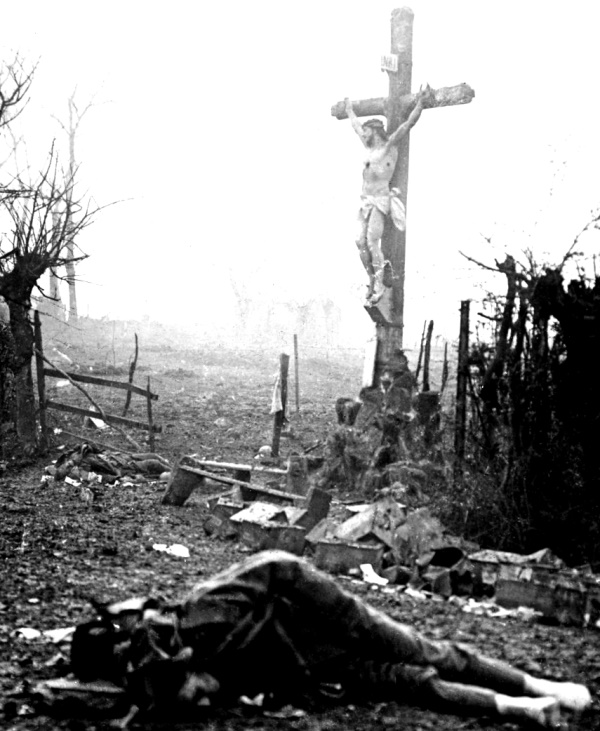 They were disarmed and kept at the local guard-house; the same thing happened to some men of the Infantry. Seven men of my company returned in the evening; what became of the other two I have not been able to find out.
They were disarmed and kept at the local guard-house; the same thing happened to some men of the Infantry. Seven men of my company returned in the evening; what became of the other two I have not been able to find out.
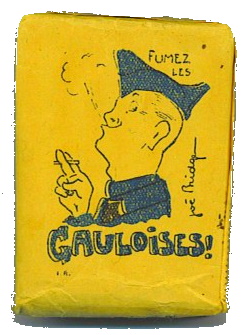
At that time a great tobacco famine reigned among us soldiers. I know that one mark and more was paid for a single cigarette, if any could be got at all.
At Vivier au Court there was only one tobacco store run by a man employed by the state.
I have seen that man being forced by sergeants at the point of the pistol to deliver his whole store of tobacco for a worthless order of requisition. The gentlemen later on sold that tobacco for half a mark a packet.
Towards the evening we marched off, and got the mortar battery in a new position from where the enemy’s positions on the Meuse were bombarded.
 After a short march we engaged the French to the northeast of Donchéry. On this side of the Meuse River, the enemy had only his rearguard, whose task was to cover the crossing of the main French armies, a movement which was almost exclusively effected at Sedan and Donchéry.
After a short march we engaged the French to the northeast of Donchéry. On this side of the Meuse River, the enemy had only his rearguard, whose task was to cover the crossing of the main French armies, a movement which was almost exclusively effected at Sedan and Donchéry.
We stuck close to the heels of our opponents, who did not retreat completely till darkness began to fall. The few bridges left did not allow him to withdraw his forces altogether as quickly as his interest demanded. Thus it came about that an uncommonly murderous nocturnal street fight took place in Donchéry which was burning at every corner.

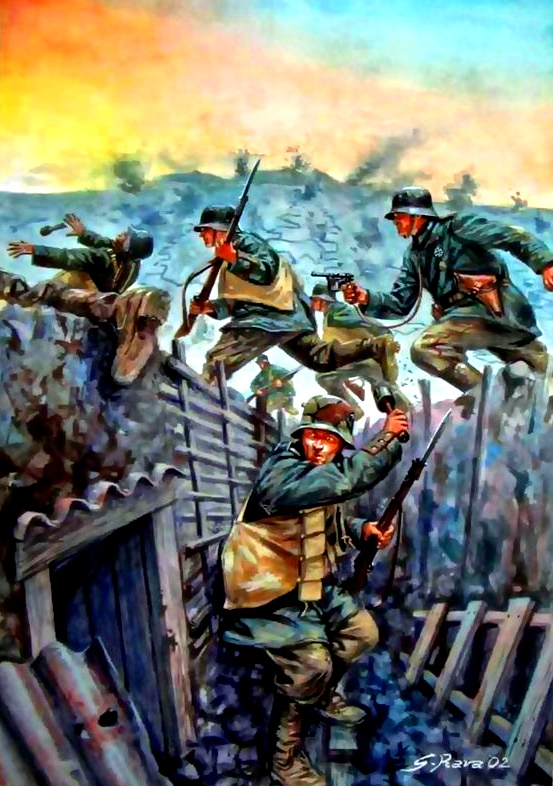
The French fought with immense energy as an awful slaughter was the result. Man against Man! That Man against Man is the most terrible thing I have experienced in war. Nobody can tell afterward how many he has killed. You have gripped your opponent, who is sometimes weaker, sometimes stronger than yourself.
In the light of the burning houses, you observe that the white of his eyes has turned red; his mouth is covered with a thick froth. With head uncovered, with disheveled hair, the uniform unbuttoned and mostly ragged, you stab, hew, scratch, bite and strike about you like a wild animal. It means life or death. You fight for your life. No quarter is given.
You only hear the gasping, groaning, jerky breathing. You only think of your own life, of death, of home. In feverish haste, as in a whirlwind, old memories are rushing through your mind. Yet you get more excited from minute to minute, for exhaustion tries to master you but that must not be, not now. And again the fight is renewed.
Again there is hewing, stabbing, biting. Without rifle, without any weapon in a life and death struggle. You or? Never! you! The exertion becomes superhuman. Now a thrust, a vicious bite, and you are the victor.
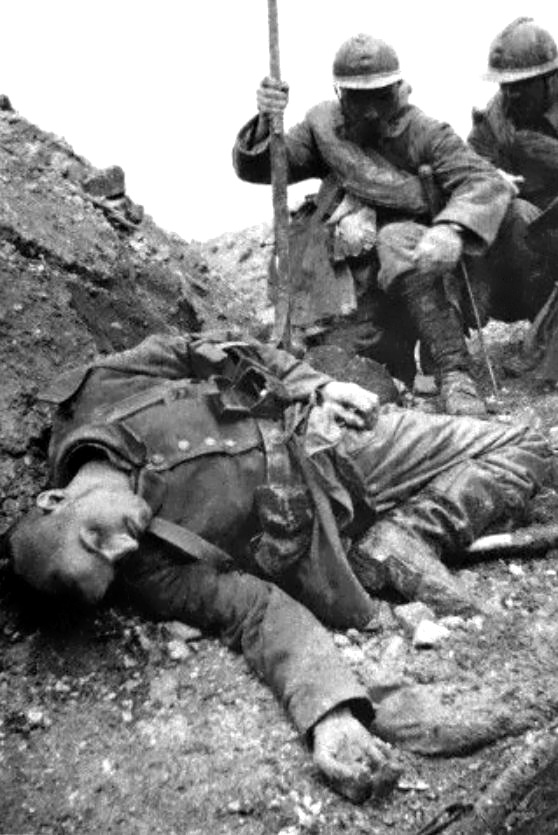 Victory for the moment, for already the next man, who has just finished off one of your mates, is upon you. You suddenly remember that you have a dagger about you. After a hasty fumbling, you find it in the prescribed place. A swift movement and the dagger buries itself deeply in the body of the other man. Onward! Onward! new enemies are coming up, real enemies. How clearly the thought suddenly flashes on you that that man is your enemy, that he is seeking to take your life, that he bites, strikes, and scratches, tries to force you down, and plant his dagger in your heart.
Victory for the moment, for already the next man, who has just finished off one of your mates, is upon you. You suddenly remember that you have a dagger about you. After a hasty fumbling, you find it in the prescribed place. A swift movement and the dagger buries itself deeply in the body of the other man. Onward! Onward! new enemies are coming up, real enemies. How clearly the thought suddenly flashes on you that that man is your enemy, that he is seeking to take your life, that he bites, strikes, and scratches, tries to force you down, and plant his dagger in your heart.
Again you use your dagger. Thank heavens! He is down. Saved! Still, you must have that dagger back! You pull it out of his chest. A jet of warm blood rushes out of the gaping wound and strikes your face. Human blood, warm human blood! You shake yourself, horror strikes you for only a few seconds. The next one approaches; again you have to defend your skin. Again and again, the mad murdering is repeated, all night long. Finally, towards four o’clock in the morning, the rest of the French surrendered after some companies of infantry had occupied two roads leading to the bridges.
When the French on the other side became aware of this they blew up the bridges without considering their own troops who were still on them. Germans and Frenchmen were tossed in the air, men and human limbs were sent to the sky, friend and foe found a watery grave in the Meuse. One could now survey with some calm the scene of the mighty slaughter. Dead lay upon dead, it was misery to behold them, and above and around them all there were flames and thick, choking smoke. But one was already too brutalized to feel pity at the spectacle; the feeling of humanity had been blown to all the winds. The groaning and crying, the pleading of the wounded did not touch one. Some Catholic nuns were lying dead before their convent. You saw it and passed on.
The only building that had escaped destruction was the barracks of the 25th regiment of French dragoons. However, we had not much time to inspect things, for at seven o’clock the French artillery began already sending shell after shell into the village. We entrenched behind a thick garden wall, immediately behind the Meuse River. Our side of the Meuse was flat, the opposite one went up steeply.
There the French infantry had entrenched themselves, having built three positions on the slope, one tier above the other. As the enemy’s artillery overshot the mark we remained outside their fire. We had however an opportunity to observe the effects of the shots sent by our own artillery into the enemy’s infantry position on the slope in front of us. The 21-CM shells whizzed above our heads and burst with a tremendous noise, each time causing horrible devastation in the enemy’s trenches. The French were unable to resist long such a hail of shells. They retreated and abandoned all the heights of the Meuse. They had evacuated the town of Sedan without a struggle. In fact, that town remained completely intact, in contrast to the completely demolished Donchéry. Not a house in Sedan had suffered.
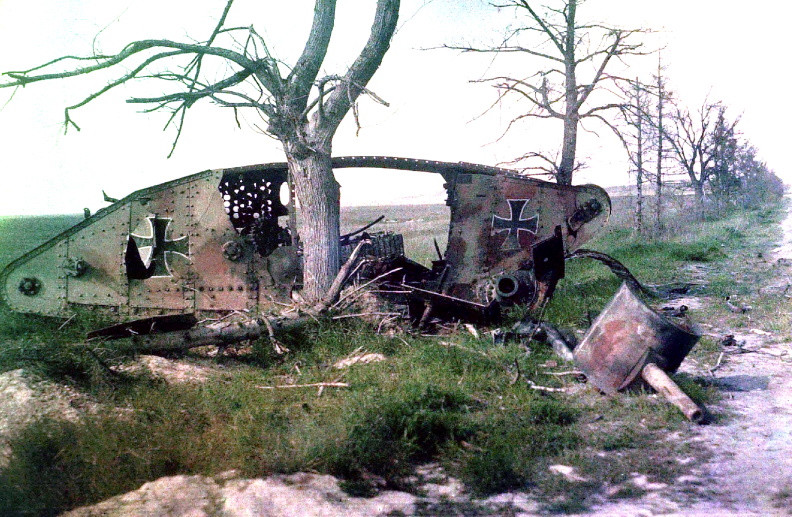 When the rallying call was sounded at Donchéry it turned out that my company had lost thirty men in that fight. We mustered behind the barracks of the dragoons, and our company, which had shrunk to ninety men, was ordered to try and build a pontoon bridge across the Meuse River at a place as yet unknown to us. Having been reinforced by eighty men of the second company we marched away in small groups so as not to draw the enemy’s attention to us and after an hour march, we halted in a small wood, about 200 yards away from the Meuse River. There we were allowed to rest until darkness began to fall.
When the rallying call was sounded at Donchéry it turned out that my company had lost thirty men in that fight. We mustered behind the barracks of the dragoons, and our company, which had shrunk to ninety men, was ordered to try and build a pontoon bridge across the Meuse River at a place as yet unknown to us. Having been reinforced by eighty men of the second company we marched away in small groups so as not to draw the enemy’s attention to us and after an hour march, we halted in a small wood, about 200 yards away from the Meuse River. There we were allowed to rest until darkness began to fall.
When it had become dark the bridge transportation column, it was that belonging to our division, came up across the fields to be followed soon after by that of the army corps. All preparations having been made and the chief preliminaries, like the placing of the trestle and the landing boards, gone through, the various pontoon-wagons drove up noiselessly, in order to be unloaded just as noiselessly and with lightning speed. We had already finished four pontoons, i. e., twenty yards of bridge, without being observed by our opponent. Everything went on all right. Suddenly the transportable searchlights of the enemy went into action and swept up and down the river. Though we had thrown ourselves flat upon the ground wherever we stood, our opponents had observed us, for the searchlights kept moving a little to and for and finally kept our spot under continual illumination. We were discovered. We scarcely had time to consider, for an artillery volley almost immediately struck the water to our left and right.
We were still lying flat on the ground when four more shots came along. That time a little nearer to the bridge, and one-shot struck the bank of the river. Immediately another volley followed, and two shells struck the bridge. Some sappers fell into the water and two fell dead on the bridge; those in the water swam ashore and escaped with a cold ducking. One only was drowned. It was the man of whom I told before that he was despised by his fellow soldiers because he had hurt the child of a poor woman with a stone he had thrown through the window into her room.








